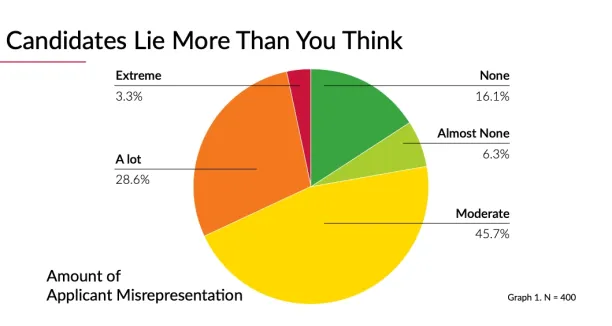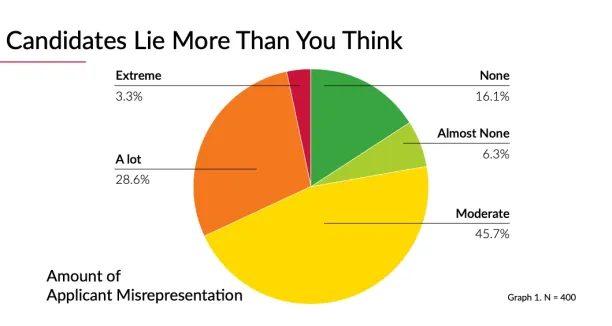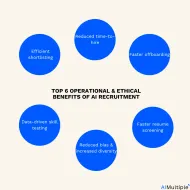Automated Background Screening in 2024
According to a set of surveys conducted with job applicants and hiring managers:
- Only around 16% of candidates say that they never lie or misrepresent information during the hiring process (Figure 1)
- More than 65% of recruiters say they are willing to hire someone despite misrepresentation (Figure 2)
Figure 1. Amount of misrepresentation during job applications. Source: Checkster

To make better hiring decisions, employers should use digital technologies to check and verify background information provided by job applicants.
In this article, we’ll explore automated background screening, how it works, the challenges of manual screening, and the benefits of automated background checks.
Figure 2. What would recruiters do if an applicant misrepresents background information? Source: Checkster

What is automated background screening?
Automated background screening uses technology to check an individual’s background quickly and efficiently for certain information. This can include information such as:
- Criminal records
- Employment history
- Educational qualifications
- Credit history
Automated background screening aims to make the process of conducting background checks more efficient and accurate, allowing employers to make informed decisions about job applicants more quickly.
How does background check automation work?
Automating background screening involves either specialized background check software, or process automation tools such as RPA and intelligent automation. Either way, the automation tool is integrated with other HR systems, such as the applicant tracking system (ATS), to streamline the hiring workflow. Background check automation can involve technologies such as:
- AI technologies such as natural language processing (NLP), computer vision, OCR, and intelligent document processing to process unstructured documents and extract data from them
- RPA / intelligent automation to automate data extraction, comparison, and migration through software bots
- Blockchain to securely store, share, and validate information provided by applicants
These technologies allow businesses to automate complex background screening tasks with unstructured data, such as:
- Getting consent from the applicant for the background screening
- Collecting data about the candidate from different data sources such as criminal record databases, court records, credit records, ID and driver’s license information from public authorities, sanctions lists, or social media accounts
- Contacting references or past employers
- Verifying provided information by cross-checking against collected data
- Contacting the applicant about the results and providing them copies of their background reports
What are the challenges of manual background screening?
Some challenges associated with manual background screening are:
- Lack of a standard background screening policy: Performing background checks doesn’t ensure that your recruitment team conducts them consistently across all applications. Manual screening is prone to human error and non-standard processes.
- Time-consuming tasks can lead to hiring with insufficient screening: Screening can be time-consuming, and organizations may skip some subtasks when handling these processes manually. The background check process involves tasks such as:
- collecting data from different sources
- reviewing and verifying the information for accuracy
- resolving any discrepancies or inconsistencies.
- Hard to customize the screening process for different roles and situations: Each job and each applicant may have different requirements and considerations. The background screening process must be tailored to take these into account. This can be difficult to do manually, as it requires a thorough understanding of the job requirements and the ability to assess and evaluate the information collected quickly and accurately.
What are the benefits of background screening automation?
It enables faster background checks
AI and process automation tools can automate many of the tasks involved in background screening, such as data collection, verification, and analysis, which can speed up the process significantly. Intelligent bots can reduce the time and the need for manual data entry and review by:
- Quickly searching and analyzing large volumes of data from various sources, such as public records and criminal databases
- Identifying relevant applicant information
- Generating reports about the results of the screening
Blockchain technology can provide a secure and tamper-proof repository for background screening data, which can help to streamline the verification process. Since blockchain records are decentralized and encrypted, they can be accessed and verified without intermediaries. This can make it easier to confirm the accuracy and completeness of the collected information and to ensure that it is up-to-date and relevant to the job in question.
For instance, MIT now offers graduates a blockchain-based diploma that employers can instantly verify.1
It can allow continuous background screening
Using AI and RPA in background screening can enable continuous monitoring of an individual’s background rather than just during the hiring period. This can be achieved by setting up automated processes that regularly collect and analyze information about an individual, such as their criminal records.
This can help identify any changes or developments in an individual’s background that may be relevant to their employment and allow organizations to take appropriate action if necessary.
However, employers should consider compliance with relevant regulations when switching to continuous background checks. For example, Fair Credit Reporting Act (FCRA) requires companies in the US to disclose that a background check is required and to obtain written consent from the employee.2
It can help reduce bias
Manual background screening is susceptible to human bias if the recruitment team does not have clear guidelines to follow. They can rely on their prejudices and preconceived notions when evaluating an individual’s background. This can result in:
- Unequal treatment of individuals and blanket bans based on arrests or convictions
- Claims of employment discrimination under federal laws such as the Civil Rights Act
More than 70% of Americans say employers should eliminate or reduce blanket bans that automatically reject job seekers with minor criminal offenses.3 By using data-driven AI algorithms to collect, compile, and analyze information, organizations can:
- Minimize the potential for human bias to influence the outcome of a background check and ensure that individuals are evaluated based on relevant and accurate information rather than on subjective factors
- Standardize and consistently apply their background screening processes, which can help reduce the potential for bias in hiring decisions
However, AI algorithms are as good as the data they are trained with, so there are also many examples of biased decisions by AI. Check our comprehensive article on examples of AI bias and how you can minimize it.
For more on HR automation
You can check our articles on:
If you have other questions about background screening automation, feel free to reach out:
External Links
- 1. Schembri, Frankie. “Digital diplomas.” MIT Technology Review. 25 April 2018. Accessed 16 December 2022.
- 2. “Fair Credit Reporting Act.” Federal Trade Commission. Accessed 16 December 2022.
- 3. “Survey Reveals Americans Want Employers To End Discrimination Against Job Seekers With Criminal Backgrounds.” Kelly Services. 22 April 2021. Accessed 16 December 2022.

Cem has been the principal analyst at AIMultiple since 2017. AIMultiple informs hundreds of thousands of businesses (as per similarWeb) including 60% of Fortune 500 every month.
Cem's work has been cited by leading global publications including Business Insider, Forbes, Washington Post, global firms like Deloitte, HPE, NGOs like World Economic Forum and supranational organizations like European Commission. You can see more reputable companies and media that referenced AIMultiple.
Throughout his career, Cem served as a tech consultant, tech buyer and tech entrepreneur. He advised businesses on their enterprise software, automation, cloud, AI / ML and other technology related decisions at McKinsey & Company and Altman Solon for more than a decade. He also published a McKinsey report on digitalization.
He led technology strategy and procurement of a telco while reporting to the CEO. He has also led commercial growth of deep tech company Hypatos that reached a 7 digit annual recurring revenue and a 9 digit valuation from 0 within 2 years. Cem's work in Hypatos was covered by leading technology publications like TechCrunch and Business Insider.
Cem regularly speaks at international technology conferences. He graduated from Bogazici University as a computer engineer and holds an MBA from Columbia Business School.
To stay up-to-date on B2B tech & accelerate your enterprise:
Follow on
![AI in HR: In-depth guide with top use cases [2024]](https://research.aimultiple.com/wp-content/uploads/2017/08/top-hr-usecases-190x143.png.webp)
Comments
Your email address will not be published. All fields are required.